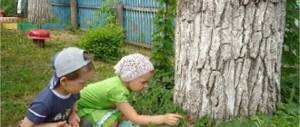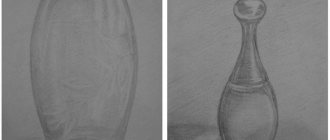Textures in watercolor
Experience the real magic of watercolor by allowing children to experiment with different ways of introducing texture into a painting. This project will teach you the all-important skill of soaking dry paint... and will teach you when to apply more paint and how much water to use.
Remember: you need good brushes and paints!
Children's enthusiasm often disappears due to lack of success because children are often given poor quality art materials. Pale paints, hard colored pencils that do not produce bright colors. Nobody will draw with them! Always give your children the best
, what do you have.
Children really see and appreciate the difference - and they are quite capable of using good paints and brushes carefully and wisely
.
In addition to high-quality student watercolors, also buy a set of professional paints; it will last for a very long time. Try to feel the difference.
Brushes are needed in different sizes and shapes, from different materials.
An old toothbrush, salt and masking fluid with a feather will help create beautiful effects.
Using a mapping pen, apply thin lines of masking fluid (contouring gel) from a center point to create a dandelion. (Younger children can use a light-colored wax pencil to draw the lines of the dandelion.) Add dots and small crosses around the edges. Spray the liquid onto the paper using a toothbrush. Let dry.
Wet the paper with a brush. Mix some watery flowers and drop them onto the paper. Take the paper and turn the sheet so that the colors blend. Let dry.
Repeat the previous step with a brighter one
and thick paint. Quickly place a drop of clean water in the center of each dandelion. Spray with a toothbrush, getting drops of different shapes and sizes. Sprinkle salt in several places. Look what's happening! Let dry.
Option using wax pencils
This master class “Drawing with watercolors with salt” involves the additional use of Suitable for older children, and if you choose a complex sketch, then an adult will also enjoy this work.
Materials:
- white wax pencil;
- watercolor paints;
- thick sheet A4;
- water;
- rock salt;
- coloring.
Having prepared all the necessary material, you can begin painting with salt and watercolors:
- Print out the drawing or draw a sketch yourself. For example, let's take a fox in winter.
- Using a wax pencil, draw snowflakes and the outline of a fox on white paper.
- Wet the sheet and fill in the sky, moon, and clouds with watercolors. You can use different shades to make the drawing more saturated.
- Before the painting is completely dry, sprinkle the sheet with salt, which will absorb the paint and sparkle.
- Let the work dry, then shake off any excess salt.
Thanks to the wax outline, the snowflakes and the fox did not blend into the background, and the salt added a fabulous shine to the landscape. This work can be done as a postcard. It’s not at all necessary to take a fox; you can sparkle any winter landscape with salt.
Drawing flowers with watercolors in elementary school
Non-traditional drawing techniques in elementary school
Master class on drawing flowers. "Rainbow Roses"
Author: Elena Yuryevna Kokorina, fine arts teacher, Slavninsk secondary school, Tver region, Torzhok district Purpose of the work: a master class on drawing is intended for primary school students and teachers, preschool children and educators, and additional education teachers. The drawing can be used to decorate the interior, as a gift or to participate in exhibitions and competitions. Goal: create a drawing depicting Rainbow Roses. Objectives: teach how to draw Rainbow Roses using different techniques: wax pencils and watercolors; develop practical skills in working with watercolors “in the raw”; develop creative abilities; cultivate accuracy in work. Rainbow dreams paint a fairy tale.
A palette of colors where joy exists. Weaving into the melody of the dominion of spring, the flowering of herbs and sweet aromas. (Vladimir Volkodav) I want to share with you a rainbow mood and tell you about the amazingly beautiful Rainbow Roses. Gardeners from the Netherlands made possible the appearance of such a miracle as rainbow-colored roses. The color of the petals is not the work of an artist, but it is also not a completely natural process, like blue roses.
The secret to creating Rainbow Roses turns out to be quite simple. This does not require any years of selection or genetic mutations. These miracle flowers are the creation of florist Peter Van de Werken, who was able to achieve the amazing effect of coloring flower petals with different shades of a magical color palette by injecting a special extract into the stem using a special technology.
Rainbow roses are created for use in unusual and bright floral arrangements, for wedding bouquets, or simply for gifts. American psychologists have found that rainbow flowers bring aesthetic pleasure and great joy to almost all people, regardless of gender. Let's draw these Rainbow Roses too. For this we will need a landscape sheet, colored wax pencils, watercolors, a double sippy cup for water, two small brushes (squirrel or pony No. 2)
There are many ways to draw roses. I offer you, in my opinion, the simplest one. Even preschool children can draw such roses, since their basis is “crescents” and “curly arcs.” We will draw immediately with colored wax pencils, drawing each petal with its own color. So, let's begin. To begin, take yellow, blue, red and orange pencils and draw four chaotic crescents, as shown in the picture - these will be the central petals of our rose. Place the drawing closer to the left edge at the top of the sheet.
Add three curly arcs in orange, blue and red.
Now let's add a yellow arc and a blue one. I hope you noticed that our petals are increasing in size each time.
Add a yellow curly arc on top, a red one on the left, and then an orange petal. Our first rose is ready.
Let's start drawing the second rose in the upper right corner. For the first two petals, take purple and blue pencils.
Now let's add two yellow arcs.
Next, we will draw new petals from different sides. Now let's see what we got.
Our largest rose will be located in the lower right part of the sheet. We will draw it using the same technology as the previous two. Let's start with the central crescents.
Now let's add a yellow curly petal.
There is an orange petal on top.
Then two blue, two purple, yellow and two orange petals. Here are our flowers ready.
Using a green pencil, add stems and leaves.
If the children are small, then this drawing can be printed for them on a printer. But children of any age can handle the second part of the work perfectly. For this we will need watercolor paints, water and brushes. In my work I use semi-dry artistic watercolors in ditches. If you don’t have one, you can use any, the main thing is to use bright colors. Let me remind you that we will work using the “raw” technique, but we will moisten the sheet gradually, in sections. To do this, we need a double sippy cup for water: in one glass there is clean water to moisten the paper, and in the second we will wash the paint from the brush. I suggest using a separate brush for moistening, this way the water in the first glass will always remain clean. So let's get started. To start, I'll take three shades of red watercolor. I have this: dark red kraplak, pink and scarlet (as I said earlier, the paint can be changed, the main thing is to maintain the color scheme).
Now let's wet all the areas of the red petals on the upper left rose, and gradually begin to introduce watercolors of all three shades. The paint will begin to mix on its own. For the yellow petals we will use lemon watercolor and golden ocher.
Let's continue painting all the yellow petals on the other roses. For blue petals, I suggest iron blue and ultramarine.
We sequentially apply each watercolor to the pre-moistened blue petals on all roses. Moistening each purple petal, we introduce turquoise and purple watercolors. Now let's move on to the orange petals. Let's take orange and English red watercolors. If you accidentally spill paint from one petal to another, don’t get upset and don’t try to smear it or blot it with a dry brush.
Ultimately, this place will have a very beautiful shade that will only decorate the rose petal. One rose had an unpainted center. Take a yellow-green watercolor and carefully paint over the remaining free space. There is no need to pre-moisten this area, since we are only using one shade of paint.
So, our roses are ready.
For the leaves, I suggest taking three shades of green: viridon, green and natural umber.
Gradually, on a pre-moistened sheet, introduce each shade of watercolor, starting from the center of the sheet.
Light paint in the middle of the sheet, darker towards the edge.
This way we will paint over all the leaves and stems of the roses.
All that remains is to fill in the background. I suggest using scarlet and lemon watercolor.
After moistening the top of the sheet, introduce lemon color.
Now let's add scarlet watercolor.
We will do the same at the bottom of the sheet.
Now the drawing can be framed.
For older children, I suggest a different drawing. The work is carried out in three stages: 1) draw the base with colored wax pencils; 2) decorate with watercolors “in the raw”; 3) using wax pencils, draw shadows and veins on the leaves and petals of roses. Let's get to work. Let's draw roses, each petal in its own color.
As in the first drawing, using different shades of paint, we begin to decorate the petals of the right rose. Now let’s decorate the “raw” leaves of the rose with different shades of green.
This is what the bottom rose will look like.
And finally, the top right rose.
Using yellow, red and blue watercolors we paint the background of our drawing.
Now you can use a thin brush and watercolor to draw the veins on the leaves and petals of the roses. But I like to emphasize the details in the drawing with wax pencils. In my opinion, this way the work looks brighter and the colors are more saturated. This is how the drawing looks when finished.
You can put it in a bright frame.
Have a good mood and creative success!
We recommend watching:
Vase with Flowers. Drawing lesson Flower drawing lesson Non-traditional drawing at school on the topic: Summer Master class on drawing for children “In a flower meadow. Butterfly" step by step with photo
Similar articles:
Master class on drawing for younger schoolchildren
Drawing on the theme “Autumn” for children in grades 1-5, step-by-step master class with photos
The autumn theme is also relevant for drawing lessons in elementary school. Most often, students in grades 1-5 are given the task of drawing autumn landscapes. Our next drawing on the theme “Autumn” is just such a step-by-step master class for children in grades 1-5. It describes in detail how to draw an autumn tree, which can be either an independent drawing or the basis for a children's landscape.
Necessary materials for drawing on the theme “Autumn” for children in grades 1-5
- paper
- colour pencils
Instructions for a drawing master class on the theme “Autumn” for children in grades 1-5
- Using a simple or black pencil, mark the base of the future tree trunk in the middle part of the leaf.
- Then using simple lines we draw the bases of the branches. First we draw the large branches, and from them we form thin small branches.
- Draw a silhouette of a crown around the resulting template.
- We add details to the tree: we draw the volume of the crown, imitate the relief of the bark and leaves with a few strokes.
- Let's move on to coloring our drawing. We start with the trunk, which we fill with strokes with a brown pencil.
- To make the crown more voluminous, we will decorate it with several colors. For example, the borders of the crown can be filled in with a red pencil.
- Then we fill the middle part of the crown with orange and yellow flowers. Photo 9 All that remains is to paint the fallen leaves in different colors and our drawing on the theme “Autumn” for children in grades 1-5 is ready!








